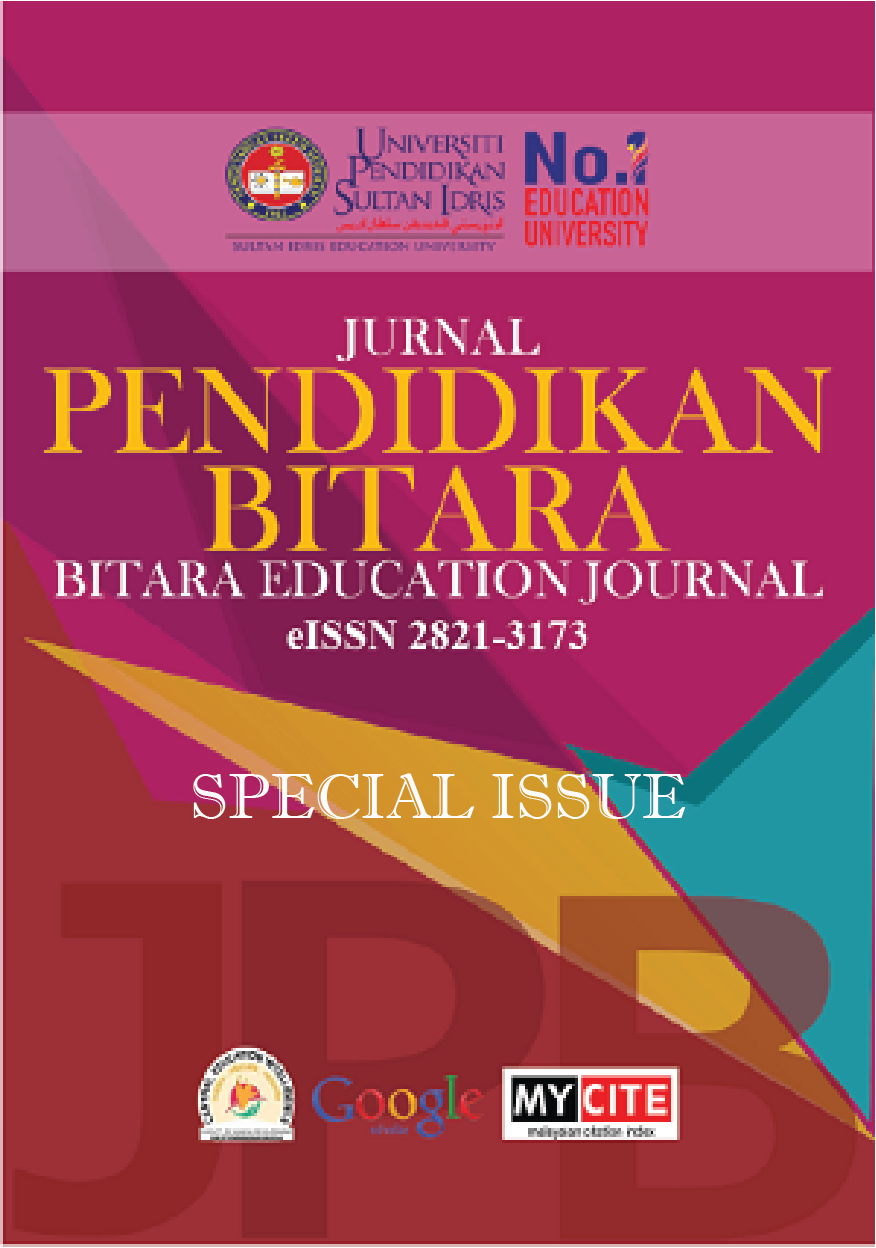Inclusive Education: Perception, Practice and Implementation Within Malaysia
DOI:
https://doi.org/10.37134/bitara.vol17.sp.13.2024Keywords:
disability-inclusive education, policy, perception, practice, implementationAbstract
As of 2022, the World Health Organisation estimates that approximately 16 percent of the global population, nearly 1.3 billion people, have some form of disability. Shockingly, the United Nations Educational, Scientific and Cultural Organization reports that at least 90 percent of children with disabilities are not attending school. Consequently, disability-inclusive education has emerged as a significant focus in global education trends. Extensive literature has addressed inclusive education, driven by international conventions advocating for every child's right to an education in an inclusive setting. From these conventions to operational directives at ministries and schools, inclusive education is consistently framed as a basic human right, entailing equal access to education in an environment that supports each student with a disability to the best of their ability. Malaysia has been proactive in aligning with global education trends, evident in its numerous education policies, particularly regarding individuals with disabilities (Orang Kurang Upaya or OKU). Notably, the Malaysian Education Blueprint 2013-2025 includes a dedicated section on the education of OKU. This paper will explore two main parts: Part One will discuss literature on inclusive education, while Part Two will examine the educational context in Malaysia. Additionally, recommendations will be proposed to establish learning communities, foster knowledge-sharing, and integrate inclusive education principles into legislation and policies within the Malaysian context. These efforts aim to ensure that future generations of Malaysian children with disabilities can fully benefit from disability-inclusive education.
Downloads
References
Adams, D., Harris, A. & Jones, M. S. (2016). Teacher-Parent Collaboration for an Inclusive Classroom: Success for Every Child. Malaysian Online Journal of Educational Sciences, 4(3), 58-71.
Agboka, E. O. (2018). Parent Teacher Cross-cultural Collaboration in Special Education [Master’s thesis, Bethel University]. Spark Repository. https://spark.bethel.edu/etd/12
Ahmad, R. H. (1998). Educational development and reformation in Malaysia: Past, present and Future. Journal of Educational Administration, 36(5), 462-475.
Azmi, S. N. (2018, December 20). Zero Reject Policy for all students. The New Straits Times. https://www.nst.com.my/news/nation/2018/12/442345/zero-reject-policy-all-students
Bosi, W. (2004). The Pilot Implementation of Inclusive Education in Malaysia: A Review. [Doctoral dissertation, Massey University]. http://mro.massey.ac.nz/xmlui/bitstream/handle/10179/1735/02_whole.pdf?sequence=1&isAllowed=y
Chow, Y. F. & Omar, H. C. (2017). Deaf Community’s Expectations on the roles of Sign Language Interpreters. The European Proceedings of Social & Behavioural Sciences. https://doi.org/10.15405/epsbs.2019.09.67
Dan, B. A., Kovács, K. E., Bacskai, K., Ceglédi, T., & Pusztai, G. (2023). Family-SEN School Collaboration and Its Importance in Guiding Educational and Health-Related Policies and Practices in the Hungarian Minority Community in Romania. International Journal of Environmental Research and Public Health, 20(3), 2054. https://doi.org/10.3390/ijerph20032054
HI. (2022, November 17). Children with disabilities still excluded from school. https://www.hi.org/en/news/children-with-disabilities-still---excluded-from-school
Kenny, N., McCoy, S. & Norman, J. O. (2023). A Whole Education Approach to Inclusive Education: An Integrated Model to Guide Planning, Policy, and Provision. Education Sciences, 13(9), 959. https://doi.org/10.3390/educsci13090959
Latiff, M. A. A., Mohamed, W. A. W., & Asran, M. A. (2015). Inclusive Education Program in Malaysia: Evolution in Policy and Challenges. Proceedings of the International Conference on Special Education, 1, 735-744.
Lee, L. W. & Low, H. M. (2014). The Evolution of Special Education in Malaysia. British Journal of Special Education, 41(1), 42-58.
Lee, L.W. (2010). Different Strategies for embracing inclusive education: A snapshot of individual cases from three countries. International Journal of Special Education, 25(3), 98-109. https://eric.ed.gov/?id=EJ909040
Losert, L. (2010). Best Practices in Inclusive Education for Children with Disabilities: Application for Program Design in the Europe & Eurasia region. Child Rights Resource Centre. https://resourcecentre.savethechildren.net/document/best-practies-in-inclusive-education/
Ministry of Education. (2013). National Education Blueprint (2013–2025). https://www.moe.gov.my/index.php/en/dasarmenu/pelan-pembangunan-pendidikan-2013-2025
Nasir, M. N. A. & Efendi, A. N. A. E. (2016). Special education for children with disabilities in Malaysia: Progress and obstacles. Malaysian Journal of Society and Space, 12(10), 78-87.
National Council for Special Education. (2010). Literature Review of the Principles & Practices relating to Inclusive Education for Children. http://ncse.ie/wp-content/uploads/2014/10/NCSE_Inclusion.pdf
Norazit, L. K. (2010). How Much Difference Can One ‘Word’ Make? Changing Perceptions of Disability in Malaysia. International Journal of Arts and Sciences, 3(15), 266-284.
Obah, A. (2024). The Effectiveness of Inclusive Education Policies for Students with Disabilities. International Journal of Humanity and Social Sciences, 2(5), 50-63. http://dx.doi.org/10.47941/ijhss.1888
Pinnock, H. & Nicholls, H. (2012). Global teacher training and inclusion survey. UNICEF Rights, Education and Protection Project. http://worldofinclusion.com/v3/wp-content/uploads/2014/01/Annex-v_Final.pdf
Singh, R. (2022). Inclusive Education in ASEAN: Fostering Belonging for Students with Disabilities. Economic Research Institute for ASEAN and East Asia.
Teng, K. Y., Yeo, K. J. & Hadijah, J. (2014, November). Implementation of Inclusive Education Programme in Malaysia [Conference paper]. 1st International Education Postgraduate Seminar, Johor Bahru.
UNESCO. (2022). Welcoming Diversity in the Learning Environment: Teacher’s Handbook for Inclusive Education. https://unesdoc.unesco.org/ark:/48223/pf0000384009/PDF/384009eng.pdf.multi.nameddest=15_Dec_Welcoming%20Diversity.indd%3A.53110%3A3396
UNICEF East Asia & Pacific. (2020). Education for Every Ability: A Review and Roadmap of Disability-Inclusive Education in East Asia and Pacific. UNICEF. https://www.unicef.org/eap/reports/education-every-ability
United Nations Human Rights Office of the High Commissioner. (n.d.). About the right to education and human rights. The United Nations Human Rights Office of the High Commissioner. https://www.ohchr.org/en/special-procedures/sr-education/about-right-education-and-human-rights
World Health Organization. (2023, March 7). Disability. https://www.who.int/news-room/fact-sheets/detail/disability-and-health
Downloads
Published
How to Cite
Issue
Section
License
Copyright (c) 2024 Chua Tuan Sek, Low Hui Min

This work is licensed under a Creative Commons Attribution-NonCommercial-ShareAlike 4.0 International License.





